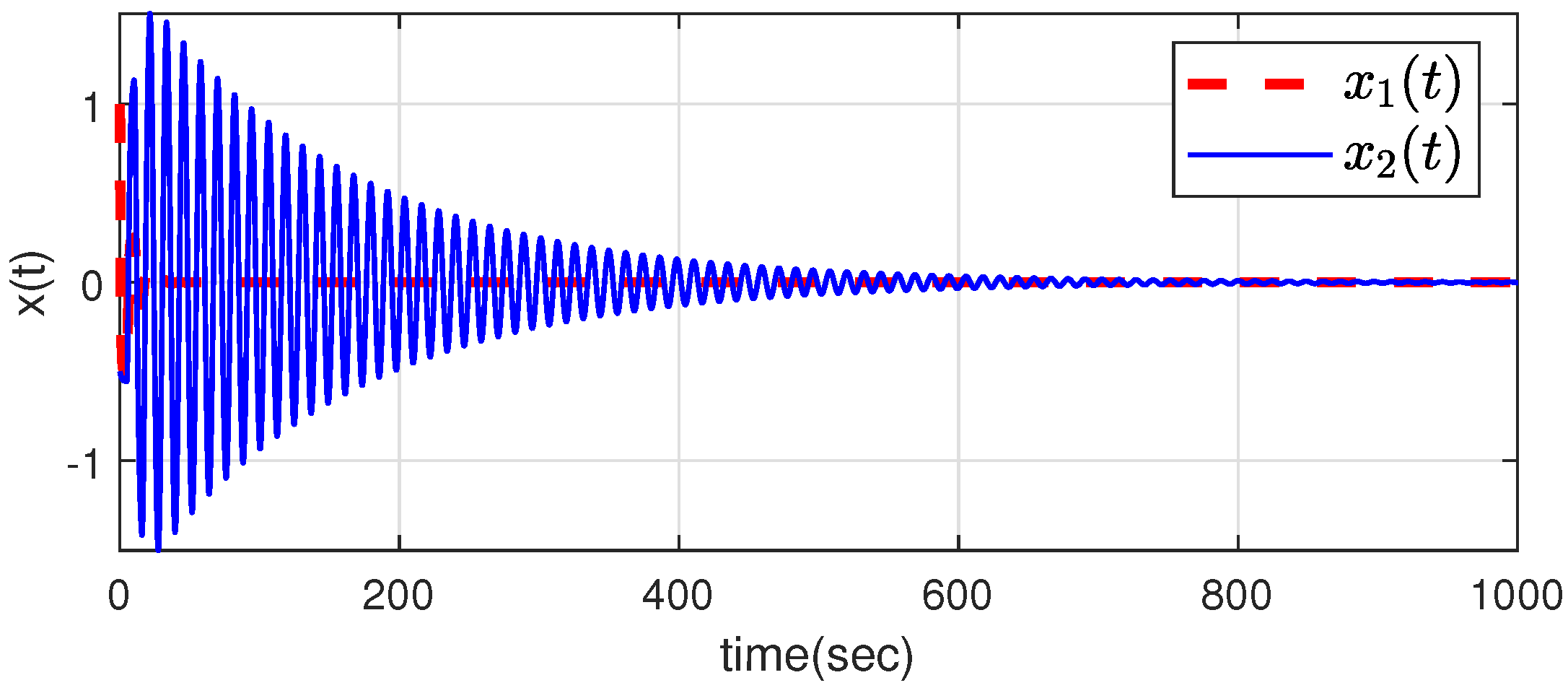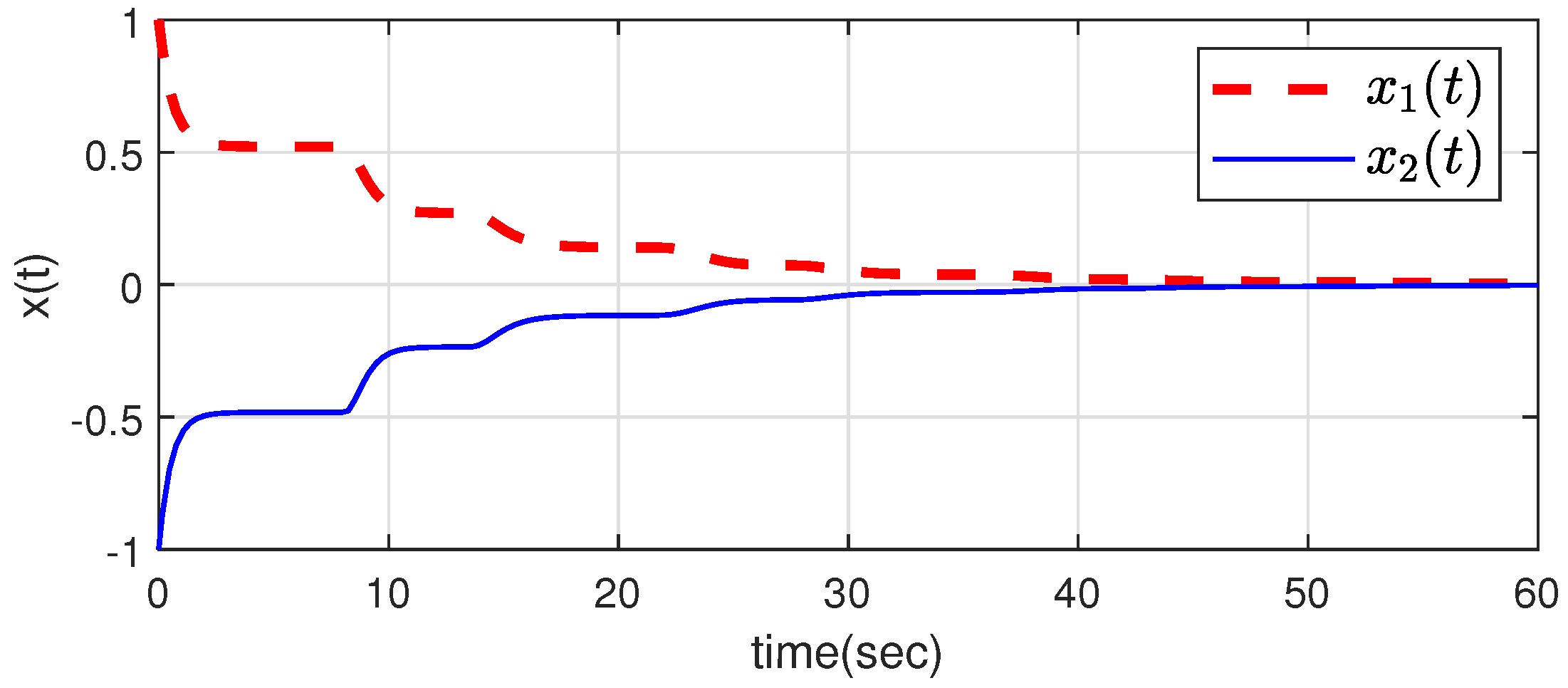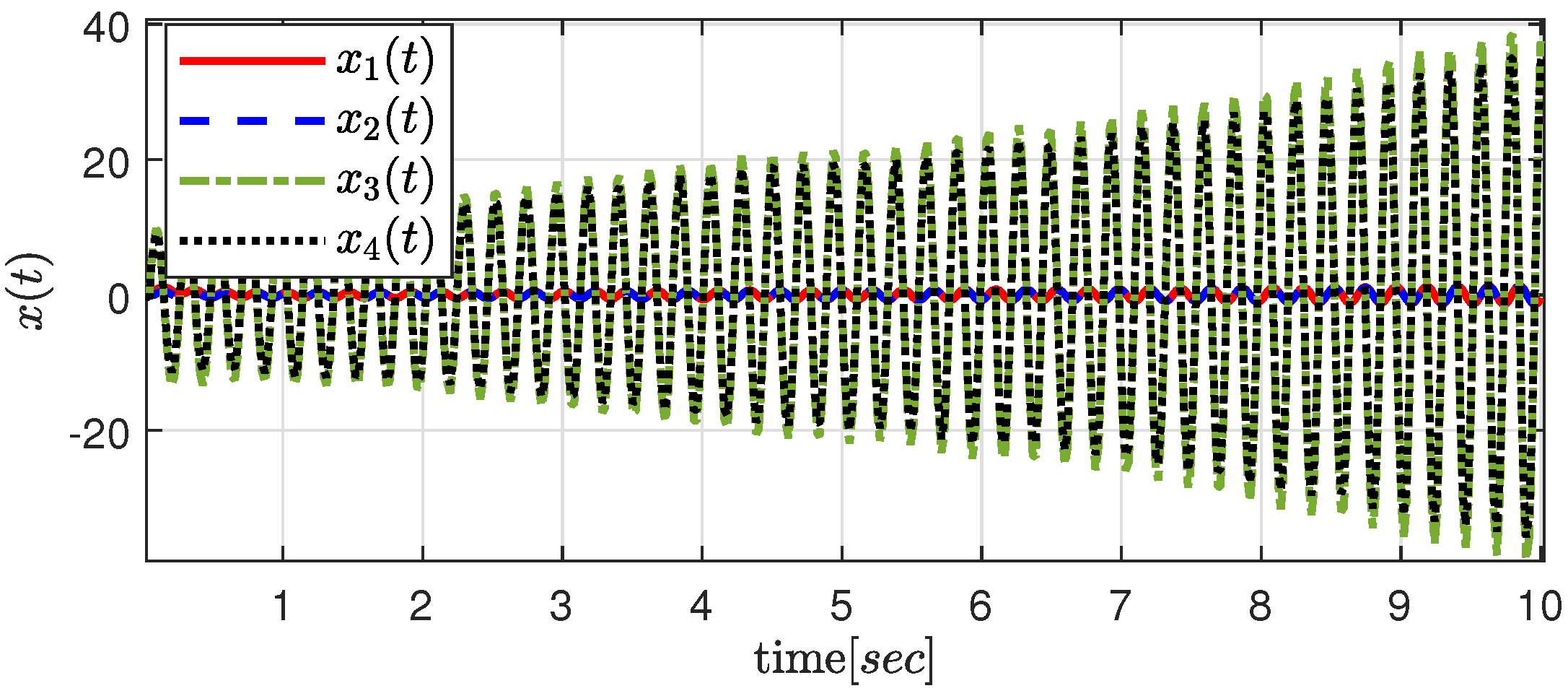Enhancing Stability Criteria for Linear Systems with Interval Time-Varying Delays via an Augmented Lyapunov–Krasovskii Functional
Abstract
:1. Introduction
2. Problem Statement
3. Main Results
4. Examples
5. Conclusions
Author Contributions
Funding
Data Availability Statement
Conflicts of Interest
Abbreviations
| LKF | Lyapunov–Krasovskii functional |
| WBII | Wirtinger-based integral inequality |
| LMI | Linear matrix inequality |
| BOD | biochemical oxygen demand |
| DO | dissolved oxygen |
| NoDVs | number of decision variables |
References
- Niculescu, S.I. Delay Effects on Stability: A Robust Control Approach; Springer Science+Business Media: London, UK, 2001; Volume 269. [Google Scholar]
- Richard, J.P. Time-delay systems: An overview of some recent advances and open problems. Automatica 2003, 39, 1667–1694. [Google Scholar] [CrossRef]
- Kwon, O.M.; Park, M.J.; Park, J.H.; Lee, S.M. Enhancement on stability criteria for linear systems with interval time-varying delays. Int. J. Control Autom. Syst. 2016, 14, 12–20. [Google Scholar] [CrossRef]
- Barbashin, E.A. Introduction of the Theory of Stability; Wolters-Noordhoff: Groningen, The Netherlands, 1970. [Google Scholar]
- Gu, K.Q.; Chen, J.; Kharitonov, V.L. Stability of Time-Delay Systems; Springer Science & Business Media: Birkhäuser Boston, MA, USA, 2003. [Google Scholar]
- Merkin, D.R. Introduction of the Theory of Stability; Springer Science & Business Media: New York, NY, USA, 2012. [Google Scholar]
- Medvedeva, I.V.; Zhabko, A.P. Synthesis of Razumikhin and Lyapunov–Krasovskii approaches to stability analysis of time-delay systems. Automatica 2015, 51, 372–377. [Google Scholar] [CrossRef]
- Zhang, X.M.; Han, Q.L.; Seuret, A.; Gouaisbaut, F.; He, Y. Overview of recent advances in stability of linear systems with time-varying delays. IET Control Theory Appl. 2019, 13, 1–16. [Google Scholar] [CrossRef]
- Park, M.J.; Kwon, O.M.; Ryu, J.H. Generalized integral inequality: Application to time-delay systems. Appl. Math. Lett. 2018, 77, 6–12. [Google Scholar] [CrossRef]
- Zeng, H.B.; Lin, H.C.; He, Y.; Teo, K.L.; Wang, W. Hierarchical stability conditions for time-varying delay systems via an extended reciprocally convex quadratic inequality. J. Frankl. Inst. Eng. Appl. Math. 2020, 357, 9930–9941. [Google Scholar] [CrossRef]
- Xu, S.Y.; Lam, J. A survey of linear matrix inequality techniques in stability analysis of delay systems. Int. J. Syst. Sci. 2008, 39, 1095–1113. [Google Scholar] [CrossRef]
- Zhang, C.K.; He, Y.; Jiang, L.; Wu, M.; Zeng, H.B. Stability analysis of systems with time-varying delay via relaxed integral inequalities. Syst. Control Lett. 2016, 92, 52–61. [Google Scholar] [CrossRef]
- He, Y.; Wang, Q.G.; Lin, C.; Wu, M. Augmented Lyapunov functional and delay-dependent stability criteria for neutral systems. Int. J. Robust Nonlinear Control 2005, 15, 923–933. [Google Scholar] [CrossRef]
- Sun, J.; Liu, G.P.; Chen, J.; Rees, D. Improved delay-range-dependent stability criteria for linear systems with time-varying delays. Automatica 2016, 92, 52–61. [Google Scholar] [CrossRef]
- Kwon, O.M.; Park, M.J.; Park, J.H.; Lee, S.M.; Cha, E.J. Improved results on stability of linear systems with time-varying delays via wirtinger-based integral inequality. J. Frankl. Inst. Eng. Appl. Math. 2014, 351, 5386–5398. [Google Scholar] [CrossRef]
- Qian, W.; Li, T.; Cong, S.; Fei, S.M. Stability analysis for interval time-varying delay systems based on time-varying bound integral method. J. Frankl. Inst. Eng. Appl. Math. 2014, 351, 4892–4903. [Google Scholar] [CrossRef]
- Lee, S.H.; Park, M.J.; Kwon, O.M.; Choi, S.G. Less conservative stability criteria for general neural networks through novel delay-dependent functional. Appl. Math. Comput. 2022, 420, 126886. [Google Scholar] [CrossRef]
- Zhao, X.; Lin, C.; Chen, B.; Wang, Q.G. Stability analysis for linear time-delay systems using new inequality based on the second-order derivative. J. Frankl. Inst. Eng. Appl. Math. 2019, 356, 8770–8784. [Google Scholar] [CrossRef]
- Gu, K.Q. An integral inequality in the stability problem of time-delay systems. In Proceedings of the 39th IEEE Conference on Decision and Control, Sydney, Australia, 12–15 December 2000; pp. 2805–2810. [Google Scholar]
- Seuret, A.; Gouaisbaut, F. Wirtinger-based integral inequality: Application to time-delay systems. Automatica 2013, 49, 2860–2866. [Google Scholar] [CrossRef]
- Gu, K.Q. A further refinement of discretized Lyapunov functional method for the stability of time-delay systems. Int. J. Control 2001, 74, 967–976. [Google Scholar] [CrossRef]
- Park, M.J.; Kwon, O.M.; Park, J.H.; Lee, S.M.; Cha, E.J. Stability of time-delay systems via Wirtinger-based double integral inequality. Automatica 2015, 55, 204–208. [Google Scholar] [CrossRef]
- Park, P.G.; Lee, W.I.; Lee, S.Y. Auxiliary function-based integral inequalities for quadratic functions and their applications to time-delay systems. J. Frankl. Inst. Eng. Appl. Math. 2015, 352, 1378–1396. [Google Scholar] [CrossRef]
- Seuret, A.; Gouaisbaut, F. Stability of linear systems with time-varying delays using bessel-legendre inequalities. IEEE Trans. Autom. Control 2018, 63, 225–232. [Google Scholar] [CrossRef]
- Zeng, H.B.; Liu, X.G.; Wang, W. A generalized free-matrix-based integral inequality for stability analysis of time-varying delay systems. Appl. Math. Comput. 2019, 354, 1–8. [Google Scholar] [CrossRef]
- Park, P.G.; Ko, J.W.; Jeong, C. Reciprocally convex approach to stability of systems with time-varying delays. Automatica 2011, 47, 235–238. [Google Scholar] [CrossRef]
- Zhang, X.M.; Han, Q.L.; Seuret, A.; Gouaisbaut, F. An improved reciprocally convex inequality and an augmented Lyapunov-Krasovskii functional for stability of linear systems with time-varying delay. Automatica 2017, 84, 221–226. [Google Scholar] [CrossRef]
- Seuret, A.; Liu, K.; Gouaisbaut, F. Generalized reciprocally convex combination lemmas and its application to time-delay systems. Automatica 2017, 84, 221–226. [Google Scholar] [CrossRef]
- Zhang, R.M.; Zeng, D.Q.; Park, J.H.; Zhong, S.M.; Liu, Y.J.; Zhou, X. New approaches to stability analysis for time-varying delay systems. J. Frankl. Inst. Eng. Appl. Math. 2019, 356, 4174–4189. [Google Scholar] [CrossRef]
- Kim, S.H.; Park, P.; Jeong, C. Robust h stabilisation of networked control systems with packet analyser. IET Control Theory Appl. 2019, 356, 4174–4189. [Google Scholar] [CrossRef]
- Lee, S.Y.; Lee, W.I.; Park, P. Improved stability criteria for linear systems with interval time-varying delays: Generalized zero equalities approach. Appl. Math. Comput. 2017, 292, 336–348. [Google Scholar] [CrossRef]
- Kwon, O.M.; Lee, S.H.; Park, M.J.; Lee, S.M. Augmented zero equality approach to stability for linear systems with time-varying delay. Appl. Math. Comput. 2020, 381, 125329. [Google Scholar] [CrossRef]
- Li, Z.C.; Yan, H.C.; Zhang, H.; Zhan, X.S.; Huang, C.Z. Improved inequality-based functions approach for stability analysis of time delay system. Automatica 2019, 108, 108416. [Google Scholar] [CrossRef]
- Li, Z.C.; Yan, H.C.; Zhang, H.; Peng, Y.; Park, J.H.; He, Y. Stability analysis of linear systems with time-varying delay via intermediate polynomial-based functions. Automatica 2020, 113, 108756. [Google Scholar] [CrossRef]
- Zhang, C.K.; Long, F.; He, Y.; Yao, W.; Jiang, L.; Wu, M. A relaxed quadratic function negative-determination lemma and its application to time-delay systems. Automatica 2020, 113, 108764. [Google Scholar] [CrossRef]
- Sheng, Z.L.; Lin, C.; Chen, B.; Wang, Q.G. Asymmetric Lyapunov-Krasovskii functional method on stability of time-delay systems. Int. J. Robust Nonlinear Control 2021, 31, 2847–2854. [Google Scholar] [CrossRef]
- De Oliveira, M.C.; Skelton, R.E. Stability tests for constrained linear systems. In Perspectives in Robust Control; Springer: London, UK, 2007; pp. 1–10. [Google Scholar]
- Liu, Y.; Hu, L.S.; Shi, P. A novel approach on stabilization for linear systems with time-varying input delay. Appl. Math. Comput. 2012, 218, 5937–5947. [Google Scholar] [CrossRef]
- Lee, C.S.; Leitmann, G. Continuous feedback guaranteeing uniform ultimate boundedness for uncertain linear delay systems—An application to river pollution-control. Comput. Math. Appl. 1988, 16, 929–938. [Google Scholar] [CrossRef]
- Aranda-Escolástico, E.; Guinaldo, M.; Gordillo, F.; Dormido, S. A novel approach to periodic event-triggered control: Design and application to the inverted pendulum. ISA Trans. 2016, 65, 327–338. [Google Scholar] [CrossRef] [PubMed]
- Liu, K.; Seuret, A.; Xia, Y. Stability analysis of systems with time-varying delays via the second-order bessel-legendre inequality. Automatica 2017, 76, 138–142. [Google Scholar] [CrossRef]
- Ren, Z.; Tian, J.K. Stability Analysis of Systems with Interval Time-Varying Delays via a New Integral Inequality. Complexity 2020, 2020, 2854293. [Google Scholar] [CrossRef]
- Lee, J.H.; Kim, J.H.; Park, P.G. A generalized multiple-integral inequality based on free matrices: Application to stability analysis of time-varying delay systems. Appl. Math. Comput. 2022, 430, 127288. [Google Scholar] [CrossRef]
- Zhai, Z.; Yan, H.; Chen, S.; Li, Z.; Wang, M. Hierarchical stability conditions for linear systems with interval time-varying delay. J. Frankl. Inst. 2024, 361, 1403–1415. [Google Scholar] [CrossRef]





| 1 | 2 | 3 | 4 | 5 | |
|---|---|---|---|---|---|
| [14] | 4.1935 | 4.4932 | 4.3979 | 4.1978 | 5.0275 |
| [38] | 4.4045 | 4.5729 | 4.5406 | 4.2367 | 5.0440 |
| [3] | 4.7561 | 4.7746 | 4.7931 | 4.7567 | 5.1372 |
| Corollary 1 | 4.7577 | 4.7715 | 4.7634 | 4.7273 | 5.1373 |
| Theorem 1 | 4.7952 | 4.8132 | 4.8110 | 4.7850 | 5.1511 |
| Theorem 2 | 4.7951 | 4.8132 | 4.8109 | 4.7849 | 5.1500 |
| 1 | 2 | 3 | 4 | 5 | |
|---|---|---|---|---|---|
| [14] | 2.3058 | 2.5663 | 3.3408 | 4.1690 | 5.0275 |
| [38] | 2.3513 | 2.6987 | 3.4186 | 4.2097 | 5.0440 |
| [3] | 2.4904 | 2.7994 | 3.4977 | 4.2939 | 5.1372 |
| Corollary 1 | 2.4752 | 2.8111 | 3.4997 | 4.2946 | 5.1373 |
| Theorem 1 | 2.5739 | 2.9247 | 3.5561 | 4.3134 | 5.1412 |
| Theorem 2 | 2.5739 | 2.9247 | 3.5593 | 4.3133 | 5.1406 |
| 1 | 2 | 3 | 4 | 5 | |
|---|---|---|---|---|---|
| [3] | 5.1893 | 6.0899 | 7.0461 | 8.0461 | 9.0461 |
| Corollary 1 | 3.8906 | 4.8426 | 5.8413 | 6.8413 | 7.8413 |
| Theorem 1 | 5.4731 | 6.2440 | 7.1456 | 8.0755 | 9.0564 |
| Theorem 2 | 5.6896 | 6.3537 | 7.1932 | 8.0908 | 9.0578 |
Disclaimer/Publisher’s Note: The statements, opinions and data contained in all publications are solely those of the individual author(s) and contributor(s) and not of MDPI and/or the editor(s). MDPI and/or the editor(s) disclaim responsibility for any injury to people or property resulting from any ideas, methods, instructions or products referred to in the content. |
© 2024 by the authors. Licensee MDPI, Basel, Switzerland. This article is an open access article distributed under the terms and conditions of the Creative Commons Attribution (CC BY) license (https://creativecommons.org/licenses/by/4.0/).
Share and Cite
Lee, D.-H.; Kim, Y.-J.; Lee, S.-H.; Kwon, O.-M. Enhancing Stability Criteria for Linear Systems with Interval Time-Varying Delays via an Augmented Lyapunov–Krasovskii Functional. Mathematics 2024, 12, 2241. https://doi.org/10.3390/math12142241
Lee D-H, Kim Y-J, Lee S-H, Kwon O-M. Enhancing Stability Criteria for Linear Systems with Interval Time-Varying Delays via an Augmented Lyapunov–Krasovskii Functional. Mathematics. 2024; 12(14):2241. https://doi.org/10.3390/math12142241
Chicago/Turabian StyleLee, Dong-Hoon, Yeong-Jae Kim, Seung-Hoon Lee, and Oh-Min Kwon. 2024. "Enhancing Stability Criteria for Linear Systems with Interval Time-Varying Delays via an Augmented Lyapunov–Krasovskii Functional" Mathematics 12, no. 14: 2241. https://doi.org/10.3390/math12142241






